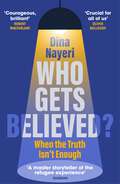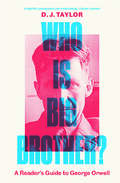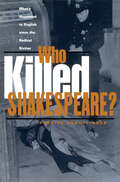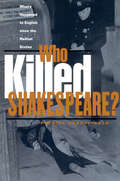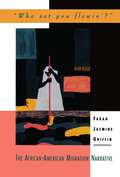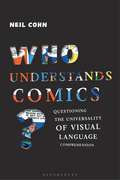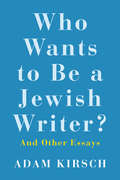- Table View
- List View
Whitman's Queer Children: America's Homosexual Epics
by Catherine A. DaviesDavies examines the work of four of the most important twentieth-century poets who have explored the epic tradition. Some of the poems display an explicit concern with ideas of American nationhood, while others emulate the formal ambitions and encyclopaedic scope of the epic poem. The study undertakes extensive close readings of Hart Crane's The Bridge (1930), Allen Ginsberg's "Howl†? (1956) and The Fall of America: Poems of These States 1965-71 (1972), James Merrill's The Changing Light at Sandover (1982), and John Ashbery's Flow Chart (1991). Although not primarily an account of a Whitmanian lineage, this book considers Whitman's renegotiation of the dialectic between the public and the private as a context for the project of the homosexual epic, arguing for the existence of a genealogy of epic poems that rethink the relationship between these two spheres. If, as Bakhtin suggests, the job of epic is to "accomplish the task of cultural, national, and political centralization of the verbal-ideological world,†? the idea of the "homosexual epic†? fundamentally problematizes the traditional aims of the genre.
Whitman's Queer Children: America's Homosexual Epics
by Catherine A. DaviesThe first full-length study to explore the idea of a ‘gay epic’ in American poetry.
Who cared for the carers?: A history of the occupational health of nurses, 1880–1948 (PDF) (Nursing History and Humanities)
by Deborah PalmerThis book compares the histories of psychiatric and voluntary hospital nurses’ health from the rise of the professional nurse in 1880 to the advent of the National Health Service in 1948. In the process it reveals the ways national ideas about the organisation of nursing impacted on the lives of ordinary nurses. It explains why the management of nurses’ health changed over time and between places, and sets these changes within a wider context of social, political and economic history. Today, high rates of sickness absence in the nursing profession attract increasing criticism. Nurses took more days off sick in 2011 than private sector employees and most other groups of public sector workers. This book argues that the roots of today’s problems are embedded in the ways nurses were managed in the late nineteenth and early twentieth centuries. It offers insights not only into the history of women’s work but also the history of disease and the ways changing scientific knowledge shaped the management of nurses’ health.
Who cared for the carers?: A history of the occupational health of nurses, 1880–1948 (Nursing History and Humanities)
by Deborah PalmerThis book compares the histories of psychiatric and voluntary hospital nurses’ health from the rise of the professional nurse in 1880 to the advent of the National Health Service in 1948. In the process it reveals the ways national ideas about the organisation of nursing impacted on the lives of ordinary nurses. It explains why the management of nurses’ health changed over time and between places, and sets these changes within a wider context of social, political and economic history. Today, high rates of sickness absence in the nursing profession attract increasing criticism. Nurses took more days off sick in 2011 than private sector employees and most other groups of public sector workers. This book argues that the roots of today’s problems are embedded in the ways nurses were managed in the late nineteenth and early twentieth centuries. It offers insights not only into the history of women’s work but also the history of disease and the ways changing scientific knowledge shaped the management of nurses’ health.
Who Cares?: Christianity and Modern Problems
by F. G. HerodOriginally published in 1981, Who Cares? Christianity and Modern Problems explores a wide range of social problems and how they relate to Christianity. The book covers a variety of topics, including family, poverty, money, race, work, war, leisure, government, sex and marriage, and religion. In each case, it draws connections to Christian teaching and reflects the facts and attitudes of the time in which it was written. Adopting a flexible approach to study, the chapters and subjects discussed can be read in any order. The book is also equipped with a selection of exam questions set by various examining boards at the time of original publication. Who Cares? Christianity and Modern Problems will appeal to those with an interest in social history, religious history, and education.
Who Cares?: Christianity and Modern Problems
by F. G. HerodOriginally published in 1981, Who Cares? Christianity and Modern Problems explores a wide range of social problems and how they relate to Christianity. The book covers a variety of topics, including family, poverty, money, race, work, war, leisure, government, sex and marriage, and religion. In each case, it draws connections to Christian teaching and reflects the facts and attitudes of the time in which it was written. Adopting a flexible approach to study, the chapters and subjects discussed can be read in any order. The book is also equipped with a selection of exam questions set by various examining boards at the time of original publication. Who Cares? Christianity and Modern Problems will appeal to those with an interest in social history, religious history, and education.
Who Cares (Modern Plays)
by Matt WoodheadIn Salford alone, 34,000 children are caring for someone.Adapted from real-life testimonies, this bold and pertinent piece of documentary theatre examines our failing care system, the impact of austerity and what happens when a child becomes the parent.Jade, Connor and Nicole all care for parents and siblings. They must juggle school and homework with caring for family members, making appointments, collecting prescriptions and running the home. Their hidden lives of caring have impacted their education, social life and health. Their testimonies are woven together, alongside those of social workers and parents, in this hard-hitting play. "It's tear-jerking throughout – accidents, abuse, disability, depression and suicide, all born on the backs of teenagers – and infuriating, too. Woodhead's script, filleted from interviews with real people who really faced these issues, points the finger squarely at austerity and its crippling effects on local councils and the services they can provide." (The Stage)A gripping verbatim theatre production based on a year of interviews that offers a rare insight into a year in the lives of young carers.
Who Cares (Modern Plays)
by Matt WoodheadIn Salford alone, 34,000 children are caring for someone.Adapted from real-life testimonies, this bold and pertinent piece of documentary theatre examines our failing care system, the impact of austerity and what happens when a child becomes the parent.Jade, Connor and Nicole all care for parents and siblings. They must juggle school and homework with caring for family members, making appointments, collecting prescriptions and running the home. Their hidden lives of caring have impacted their education, social life and health. Their testimonies are woven together, alongside those of social workers and parents, in this hard-hitting play. "It's tear-jerking throughout – accidents, abuse, disability, depression and suicide, all born on the backs of teenagers – and infuriating, too. Woodhead's script, filleted from interviews with real people who really faced these issues, points the finger squarely at austerity and its crippling effects on local councils and the services they can provide." (The Stage)A gripping verbatim theatre production based on a year of interviews that offers a rare insight into a year in the lives of young carers.
Who Cares
by Michael WynneA phrase we used to use: it is the best gift the British people have given to themselves. Because it is. No one else has done this.The NHS belongs to us. Over eighteen months Michael Wynne interviewed nurses, doctors, paramedics, historians, policy makers and politicians up and down the country, gathering an unrivalled collection of testimonies from those connected to every aspect of the NHS. In a this verbatim play, he gives voice to unheard perspectives on its past, present and possible future.Who Cares premiered at the Royal Court Theatre, London, in April 2015 in the run up to the General Election.
Who Gets Believed?: When the Truth Isn’t Enough
by Dina NayeriThe prizewinning author of The Ungrateful Refugee asks who is believed in our society, who is not - and why?'Ambitious and moving... it will cement Nayeri's position as a master storyteller of the refugee experience' Guardian Dina Nayeri's wide-ranging, groundbreaking new book combines deep reportage with her own life experience to examine what constitutes believability in our society. Intent on exploring ideas of persuasion and performance, Nayeri takes us behind the scenes in emergency rooms, corporate boardrooms, asylum interviews and into her own family, to ask - where lies the difference between being believed and being dismissed? What does this mean for our culture?As personal as it is profound in its reflections on language, history, morality and compassion, Who Gets Believed? investigates the unspoken social codes that determine how we relate to one another.'An important, courageous, brilliant book' Robert Macfarlane, bestselling author of Underland'Dina Nayeri asks an incredibly important question, and the answers she finds are crucial for all of us' Oliver Bullough, bestselling author of Butler to the World'I was hugely moved by this book. Who Gets Believed? is essential reading, an extraordinary labour of love and hope that is destined to become indispensable in the continuing struggle for justice' John Burnside, winner of the David Cohen Prize for Literature 2023
Who Is Big Brother?: A Reader's Guide to George Orwell
by D. J. TaylorA spirited and essential companion to Orwell and his works, covering all the novels and major essays An intellectual who hated intellectuals, a socialist who didn’t trust the state—our foremost political essayist and author of Animal Farm and Nineteen Eighty-Four was a man of stark, puzzling contradictions. Knowing Orwell’s life and reading Orwell’s works produces just as many questions as it answers. Celebrated Orwell biographer D. J. Taylor guides fans and new readers alike through the many twists and turns of Orwell’s books, life and thought. As a writer he intended his works to be transparent and instantly accessible, yet they are also full of secrets and surprises, tantalising private histories, and psychological quirks. From his conflicted relationship with religion to his competing anti-imperialism and fascination with empire, Who Is Big Brother? delves into the complex development of this essential yet enigmatic voice. Taylor leads us through Orwell’s principal writings and complex life—crafting an illuminating guide to one of the most enduringly relevant writers in the English language.
Who Is Dracula’s Father?: And Other Puzzles in Bram Stoker’s Gothic Masterpiece
by John SutherlandWhen it was first published in 1897 – 120 years ago – Irish author Bram Stoker’s Dracula was ranked by the Daily Mail above work by Mary Shelley and Edgar Allan Poe, as well as Wuthering Heights. Yet it never made Stoker any money. Since 1931’s film Nosferatu the Vampire, however, it has never been out of print and is legendary among fans of the dark, macabre and mysterious … Critic John Sutherland, a Dracula fan since childhood – and author of the literary puzzle classics Is Heathcliff a Murderer? and Can Jane Eyre be Happy? explores the enigmas and puzzles of this towering giant of gothic novels, such as: Who was Dracula’s father? Why does the Count come to England? Does the Count actually give Jonathan a ‘love bite’? Why does every country we know of have a vampire legend? And finally – how long is it before we’re all vampires? The book also includes 'Dracula Digested' by John Crace, author of the Guardian's Digested Reads column.
Who Is Ozymandias?: And other Puzzles in Poetry
by John FullerPart of the pleasure of poetry is unravelling the mysteries and difficulties it contains and solving the puzzles that lie within. Who, for instance, is Ozymandias? What is the Snark? Who is the Emperor of Ice-Cream? Or indeed, who is 'you' in a poem? In this perceptive and playful new book, acclaimed poet John Fuller looks at some of our greatest poems and considers the number of individual puzzles at their heart, casting light on how we should approach these conundrums as readers. From riddling to double entendres, mysterious titles to red herrings, Fuller unpicks the puzzles in works that range from Browning to Bishop, Empson to Eliot, Shelley to Stevens, to help us reach the rewards and revelations that lie at the centre of some of our best-loved poems.
Who Killed American Poetry?: From National Obsession to Elite Possession
by Karen L. KilcupThroughout the 19th century, American poetry was a profoundly populist literary form. It circulated in New England magazines and Southern newspapers; it was read aloud in taverns, homes, and schools across the country. Antebellum reviewers envisioned poetry as the touchstone democratic genre, and their Civil War–era counterparts celebrated its motivating power, singing poems on battlefields. Following the war, however, as criticism grew more professionalized and American literature emerged as an academic subject, reviewers increasingly elevated difficult, dispassionate writing and elite readers over their supposedly common counterparts, thereby separating “authentic” poetry for intellectuals from “popular” poetry for everyone else.\ Conceptually and methodologically unique among studies of 19th-century American poetry, Who Killed American Poetry? not only charts changing attitudes toward American poetry, but also applies these ideas to the work of representative individual poets. Closely analyzing hundreds of reviews and critical essays, Karen L. Kilcup tracks the century’s developing aesthetic standards and highlights the different criteria reviewers used to assess poetry based on poets’ class, gender, ethnicity, and location. She shows that, as early as the 1820s, critics began to marginalize some kinds of emotional American poetry, a shift many scholars have attributed primarily to the late-century emergence of affectively restrained modernist ideals. Mapping this literary critical history enables us to more readily apprehend poetry’s status in American culture—both in the past and present—and encourages us to scrutinize the standards of academic criticism that underwrite contemporary aesthetics and continue to constrain poetry’s appeal. Who American Killed Poetry? enlarges our understanding of American culture over the past two hundred years and will interest scholars in literary studies, historical poetics, American studies, gender studies, canon criticism, genre studies, the history of criticism, and affect studies. It will also appeal to poetry readers and those who enjoy reading about American cultural history.
Who Killed Shakespeare: What's Happened to English Since the Radical Sixties
by Patrick BrantlingerFirst published in 2001. Routledge is an imprint of Taylor & Francis, an informa company.
Who Killed Shakespeare: What's Happened to English Since the Radical Sixties
by Patrick BrantlingerFirst published in 2001. Routledge is an imprint of Taylor & Francis, an informa company.
Who Owns This Text?: Plagiarism, Authorship, and Disciplinary Cultures
by Carol Peterson Haviland Joan A. MullinCarol Haviland, Joan Mullin, and their collaborators report on a three-year interdisciplinary interview project on the subject of plagiarism, authorship, and “property,” and how these are conceived across different fields. The study investigated seven different academic fields to discover disciplinary conceptions of what types of scholarly production count as “owned.” Less a research report than a conversation, the book offers a wide range of ideas, and the chapters here will provoke discussion on scholarly practice relating to intellectual property, plagiarism, and authorship---and to how these matters are conveyed to students. Although these authors find a good deal of consensus in regard to the ethical issues of plagiarism, they document a surprising variety of practice on the subject of what ownership looks like from one discipline to another. And they discover that students are not often instructed in the conventions of their major field.
Who Reads Poetry: 50 Views from “Poetry” Magazine
by Fred Sasaki and Don Share Don ShareWho reads poetry? We know that poets do, but what about the rest of us? When and why do we turn to verse? Seeking the answer, Poetry magazine since 2005 has published a column called “The View From Here,” which has invited readers “from outside the world of poetry” to describe what has drawn them to poetry. Over the years, the incredibly diverse set of contributors have included philosophers, journalists, musicians, and artists, as well as doctors and soldiers, an iron-worker, an anthropologist, and an economist. This collection brings together fifty compelling pieces, which are in turns surprising, provocative, touching, and funny. In one essay, musician Neko Case calls poetry “a delicate, pretty lady with a candy exoskeleton on the outside of her crepe-paper dress.” In another, anthropologist Helen Fisher turns to poetry while researching the effects of love on the brain, “As other anthropologists have studied fossils, arrowheads, or pot shards to understand human thought, I studied poetry. . . . I wasn’t disappointed: everywhere poets have described the emotional fallout produced by the brain’s eruptions.” Even film critic Roger Ebert memorized the poetry of e. e. cummings, and the rapper Rhymefest attests here to the self-actualizing power of poems: “Words can create worlds, and I’ve discovered that poetry can not only be read but also lived out. My life is a poem.” Music critic Alex Ross tells us that he keeps a paperback of The Palm at the End of the Mind by Wallace Stevens on his desk next to other, more utilitarian books like a German dictionary, a King James Bible, and a Macintosh troubleshooting manual. Who Reads Poetry offers a truly unique and broad selection of perspectives and reflections, proving that poetry can be read by everyone. No matter what you’re seeking, you can find it within the lines of a poem.
Who Reads Poetry: 50 Views from “Poetry” Magazine
by Fred Sasaki and Don Share Don ShareWho reads poetry? We know that poets do, but what about the rest of us? When and why do we turn to verse? Seeking the answer, Poetry magazine since 2005 has published a column called “The View From Here,” which has invited readers “from outside the world of poetry” to describe what has drawn them to poetry. Over the years, the incredibly diverse set of contributors have included philosophers, journalists, musicians, and artists, as well as doctors and soldiers, an iron-worker, an anthropologist, and an economist. This collection brings together fifty compelling pieces, which are in turns surprising, provocative, touching, and funny. In one essay, musician Neko Case calls poetry “a delicate, pretty lady with a candy exoskeleton on the outside of her crepe-paper dress.” In another, anthropologist Helen Fisher turns to poetry while researching the effects of love on the brain, “As other anthropologists have studied fossils, arrowheads, or pot shards to understand human thought, I studied poetry. . . . I wasn’t disappointed: everywhere poets have described the emotional fallout produced by the brain’s eruptions.” Even film critic Roger Ebert memorized the poetry of e. e. cummings, and the rapper Rhymefest attests here to the self-actualizing power of poems: “Words can create worlds, and I’ve discovered that poetry can not only be read but also lived out. My life is a poem.” Music critic Alex Ross tells us that he keeps a paperback of The Palm at the End of the Mind by Wallace Stevens on his desk next to other, more utilitarian books like a German dictionary, a King James Bible, and a Macintosh troubleshooting manual. Who Reads Poetry offers a truly unique and broad selection of perspectives and reflections, proving that poetry can be read by everyone. No matter what you’re seeking, you can find it within the lines of a poem.
Who Reads Poetry: 50 Views from “Poetry” Magazine
by Fred Sasaki Don ShareWho reads poetry? We know that poets do, but what about the rest of us? When and why do we turn to verse? Seeking the answer, Poetry magazine since 2005 has published a column called “The View From Here,” which has invited readers “from outside the world of poetry” to describe what has drawn them to poetry. Over the years, the incredibly diverse set of contributors have included philosophers, journalists, musicians, and artists, as well as doctors and soldiers, an iron-worker, an anthropologist, and an economist. This collection brings together fifty compelling pieces, which are in turns surprising, provocative, touching, and funny. In one essay, musician Neko Case calls poetry “a delicate, pretty lady with a candy exoskeleton on the outside of her crepe-paper dress.” In another, anthropologist Helen Fisher turns to poetry while researching the effects of love on the brain, “As other anthropologists have studied fossils, arrowheads, or pot shards to understand human thought, I studied poetry. . . . I wasn’t disappointed: everywhere poets have described the emotional fallout produced by the brain’s eruptions.” Even film critic Roger Ebert memorized the poetry of e. e. cummings, and the rapper Rhymefest attests here to the self-actualizing power of poems: “Words can create worlds, and I’ve discovered that poetry can not only be read but also lived out. My life is a poem.” Music critic Alex Ross tells us that he keeps a paperback of The Palm at the End of the Mind by Wallace Stevens on his desk next to other, more utilitarian books like a German dictionary, a King James Bible, and a Macintosh troubleshooting manual. Who Reads Poetry offers a truly unique and broad selection of perspectives and reflections, proving that poetry can be read by everyone. No matter what you’re seeking, you can find it within the lines of a poem.
Who Reads Poetry: 50 Views from “Poetry” Magazine
by Fred Sasaki Don ShareWho reads poetry? We know that poets do, but what about the rest of us? When and why do we turn to verse? Seeking the answer, Poetry magazine since 2005 has published a column called “The View From Here,” which has invited readers “from outside the world of poetry” to describe what has drawn them to poetry. Over the years, the incredibly diverse set of contributors have included philosophers, journalists, musicians, and artists, as well as doctors and soldiers, an iron-worker, an anthropologist, and an economist. This collection brings together fifty compelling pieces, which are in turns surprising, provocative, touching, and funny. In one essay, musician Neko Case calls poetry “a delicate, pretty lady with a candy exoskeleton on the outside of her crepe-paper dress.” In another, anthropologist Helen Fisher turns to poetry while researching the effects of love on the brain, “As other anthropologists have studied fossils, arrowheads, or pot shards to understand human thought, I studied poetry. . . . I wasn’t disappointed: everywhere poets have described the emotional fallout produced by the brain’s eruptions.” Even film critic Roger Ebert memorized the poetry of e. e. cummings, and the rapper Rhymefest attests here to the self-actualizing power of poems: “Words can create worlds, and I’ve discovered that poetry can not only be read but also lived out. My life is a poem.” Music critic Alex Ross tells us that he keeps a paperback of The Palm at the End of the Mind by Wallace Stevens on his desk next to other, more utilitarian books like a German dictionary, a King James Bible, and a Macintosh troubleshooting manual. Who Reads Poetry offers a truly unique and broad selection of perspectives and reflections, proving that poetry can be read by everyone. No matter what you’re seeking, you can find it within the lines of a poem.
"Who Set You Flowin'?": The African-American Migration Narrative (Race and American Culture)
by Farah Jasmine GriffinTwentieth-century America has witnessed the most widespread and sustained movement of African-Americans from the South to urban centers in the North. Who Set You Flowin'? examines the impact of this dislocation and urbanization, identifying the resulting Migration Narratives as a major genre in African-American cultural production. Griffin takes an interdisciplinary approach with readings of several literary texts, migrant correspondence, painting, photography, rap music, blues, and rhythm and blues. From these various sources Griffin isolates the tropes of Ancestor, Stranger, and Safe Space, which, though common to all Migration Narratives, vary in their portrayal. She argues that the emergence of a dominant portrayal of these tropes is the product of the historical and political moment, often challenged by alternative portrayals in other texts or artistic forms, as well as intra-textually. Richard Wright's bleak, yet cosmopolitan portraits were countered by Dorothy West's longing for Black Southern communities. Ralph Ellison, while continuing Wright's vision, reexamined the significance of Black Southern culture. Griffin concludes with Toni Morrison embracing the South "as a site of African-American history and culture," "a place to be redeemed."
Who Understands Comics?: Questioning the Universality of Visual Language Comprehension
by Neil CohnDrawings and sequential images are so pervasive in contemporary society that we may take their understanding for granted. But how transparent are they really, and how universally are they understood? Combining recent advances from linguistics, cognitive science, and clinical psychology, this book argues that visual narratives involve greater complexity and require a lot more decoding than widely thought. Although increasingly used beyond the sphere of entertainment as materials in humanitarian, educational, and experimental contexts, Neil Cohn demonstrates that their universal comprehension cannot be assumed. Instead, understanding a visual language requires a fluency that is contingent on exposure and practice with a graphic system. Bringing together a rich but scattered literature on how people comprehend, and learn to comprehend, a sequence of images, this book coalesces research from a diverse range of fields into a broader interdisciplinary view of visual narrative to ask: Who Understands Comics?
Who Understands Comics?: Questioning the Universality of Visual Language Comprehension
by Neil CohnDrawings and sequential images are so pervasive in contemporary society that we may take their understanding for granted. But how transparent are they really, and how universally are they understood? Combining recent advances from linguistics, cognitive science, and clinical psychology, this book argues that visual narratives involve greater complexity and require a lot more decoding than widely thought. Although increasingly used beyond the sphere of entertainment as materials in humanitarian, educational, and experimental contexts, Neil Cohn demonstrates that their universal comprehension cannot be assumed. Instead, understanding a visual language requires a fluency that is contingent on exposure and practice with a graphic system. Bringing together a rich but scattered literature on how people comprehend, and learn to comprehend, a sequence of images, this book coalesces research from a diverse range of fields into a broader interdisciplinary view of visual narrative to ask: Who Understands Comics?
Who Wants to Be a Jewish Writer?: And Other Essays
by Adam KirschFrom one of today’s keenest critics comes a collection of essays on poetry, religion, and the connection between the two Adam Kirsch is one of today’s finest literary critics. This collection brings together his essays on poetry, religion, and the intersections between them, with a particular focus on Jewish literature. He explores the definition of Jewish literature, the relationship between poetry and politics, and the future of literary reputation in the age of the internet. Several essays look at the way Jewish writers such as Stefan Zweig and Isaac Deutscher, who coined the phrase “the non†‘Jewish Jew,” have dealt with politics. Kirsch also examines questions of spirituality and morality in the writings of contemporary poets, including Christian Wiman, Kay Ryan, and Seamus Heaney. He closes by asking why so many American Jewish writers have resisted that category, inviting us to consider “Is there such a thing as Jewish literature?”







